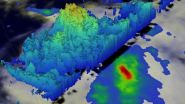Due to the unprecedented destruction of the 2005 storm season, recovery efforts traditionally supported by insurance and FEMA were supplemented by a unique set of programs funded through $13.4 billion of Community Development Block Grant-Disaster Recovery, or CDBG-DR funds.
The researchers from the LSU AgCenter and E. J. Ourso College of Business focused on studying the impact of these programs on the recovery of three key sectors--housing, infrastructure and economic development. The new reports provides the State of Louisiana with a baseline for future research on the effectiveness and economic impact of CDBG-DR funds on the long-term recovery in Louisiana.
"This study provides an important first step toward measuring the impact these large-scale programs had on the recovery efforts. Our initial analysis suggests that population and business activity grew more rapidly after recovery funds were disbursed. As we continue this analysis, we hope to more fully assess the programs developed in response to the 2005 storm season and to identify best practices that can guide future disaster recovery efforts," said Stephen Barnes, LSU assistant professor in the department of economics and director of the Division of Economic Development.
The reports were conducted for the Office of Community Development-Disaster Recovery Unit in Louisiana's Division of Administration and the City of New Orleans.
"Increased fiscal stress and examples of local governments going bankrupt in recent years created concerns that Hurricanes Katrina and Rita would result in long-run financial challenges. However, our research shows a link between investments made and increased solvency of parish governments since these storms. This will help sustain the delivery of public services that otherwise might have been in jeopardy," said Matthew Fannin, LSU AgCenter associate professor in agricultural economics and agribusiness.
The key findings from the reports are as follows:
Housing
About 515,000 housing units in Louisiana were damaged and more than 200,000 units were destroyed. Homeowners, landlords and developers received CDBG-DR funds. About 92 percent of homeowners opted to rebuild and remain in Louisiana.
Assistance from three programs--the Homeowner Assistance Program, the Small Rental Property Program and the Low Income Housing Tax Credit Piggyback Program--appears to have been more concentrated in places facing the greatest recovery challenges. Areas that received more disbursements seemed to experience accelerated recovery statewide and by planning district in New Orleans. One exception to this is in Algiers, where no significant correlation was found between dollars and recovery for the Homeowner Assistance Program. In New Orleans, there were also positive correlations between disbursements to homeowners and population growth from one to three years after the hurricanes. Populations appear to have returned and stayed in the affected areas. Upon further review of emergency permits in Orleans Parish, homeowners began to repair their homes after receiving their Homeowner Assistance Program disbursement. In New Orleans, property tax data reveals there was an initial spike in median home prices in the months following the storm, likely driven by a shortage of supply, but housing sale prices normalized in mid-2013 and eventually fell below pre-storm levels. Although there is no significant correlation between disbursements from the CDBG-DR programs and house prices, further analysis is necessary to determine the ultimate impact of program dollars on the real estate market in New Orleans. Infrastructure
About $7.6 billion from the FEMA Public Assistance program and CDBG-DR funded program has been invested in infrastructure repair and restoration in the 37 parishes affected by Hurricanes Katrina and Rita through May 2015.
When billions of infrastructure dollars were being invested across the state, parish governments' fiscal health improved. Total assets for the 37 parish governments increased by nearly 60 percent or more than $17 billion, which is not adjusted for inflation, from 2005-2013. The combined debt-to-asset ratio of the 37 parish governments that received Public Assistance and/or CDBG-DR infrastructure investments declined by more than 10 percent from 0.44 to 0.39, placing these parishes in a healthy fiscal position for long-term fiscal sustainability. Parish governments that received some of the largest investments per capita saw some of the largest improvements in their solvency by their debt-to-asset ratios declining more than 50 percent. Economic Development
Post-Katrina and Rita economic development programs provided about $165 million to small businesses through 3,482 grants and 1,044 loans, and $6.1 million in bridge loans to 768 businesses. The programs trained more than 15,000 workers, provided technical assistance to about 6,000 small firms and supported the recruitment or retention of 258 higher education faculty members.
In general, the Business Recovery Grant and Loan program was successful in helping critical sectors recover. Industries in parishes with higher disbursements under the program also saw higher rates of business expansion. Many service industries that would not typically be the target of economic development efforts showed the highest correlation between money disbursed by the program and economic growth. Many of these industries were critical for the return of the population to the area. Results indicate that the Business Recovery Grant and Loan program subsequently helped spur new startups in some sectors. Additionally, the link between disbursements and business expansions one or two years following the initial grant disbursement, suggests the program helped businesses stay open and expand. OCD-DRU Executive Director Pat Forbes said, "As we look back on a decade of rebuilding and recovery in Louisiana, it is critical that we study the impact federal dollars had on our communities. While there is much research left to be done, we are encouraged by positive trends we see that show places where housing, economic development and infrastructure dollars dramatically spurred recovery in affected areas."
"It's all about the money," said New Orleans Chief Administrative Officer Andy Kopplin. "These studies show how federal recovery dollars were allocated properly to the places that had the most damages like New Orleans and that they quickly accelerated the pace of recovery once they hit the ground. While those findings should come as no surprise, they ought to influence Congress to move even more quickly in the future to appropriate discretionary CDBG funds after catastrophe's like Hurricanes Katrina and Rita and to waive the usual rules so that state and local officials can invest them as quickly as possible."
INFORMATION:
To view and download the reports, visit MeasuringRecovery.lsu.edu.




